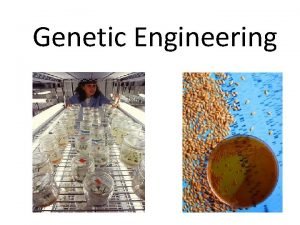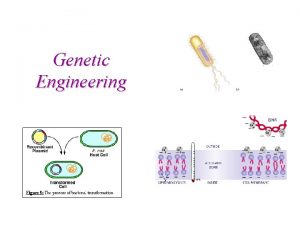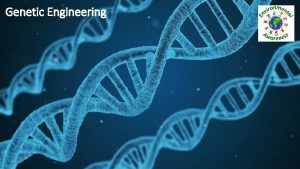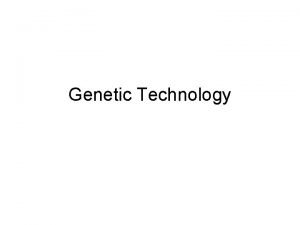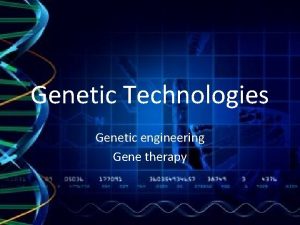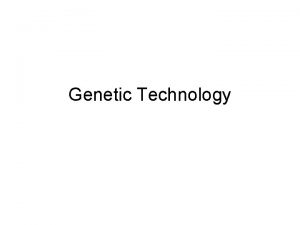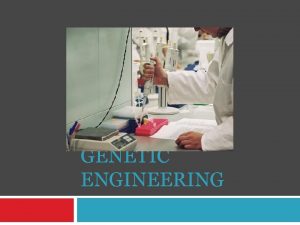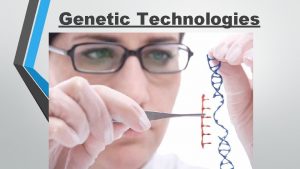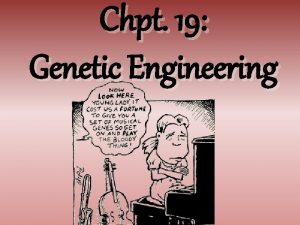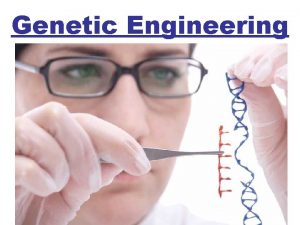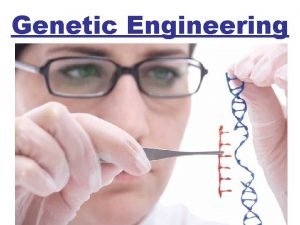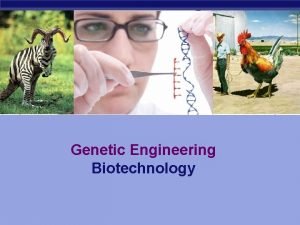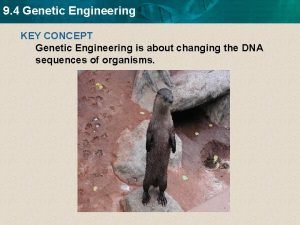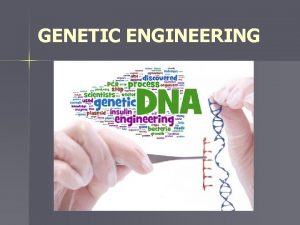Genetic Engineering Genetic Engineering Genetic Engineering The development













































- Slides: 45

Genetic Engineering

Genetic Engineering • Genetic Engineering: The development and application procedures, and technologies that allow you to directly manipulate an organisms DNA • We can manipulate DNA and genes to alter organisms or make them produce a product we need.

Genetic Engineering (g. e) 1. It is the process of inserting genes of interest into specific organisms for either a medical or scientific benefit. 2. Gene therapy is the process of inserting a missing gene into an organism. 3. Bacteria are often used as the factories to produce a protein from a cloned gene. This has led to the production of human insulin, GH & erythropoietin. . etc. 4. The gene must be cloned into an expression vector, usually a plasmid with special features that allows it to be transcribed & translated in a host cell.

Genetic Engineering in Agriculture 1. 2. 3. 4. Disease resistance e. g. corn & cotton Nitrogen fixation Frost-free plants e. g. strawberries & potatoes Tomatoes with a long shelf life deactivating the gene in tomato which produce ethylene. 5. Increased milk production giving cows bovine somatotropin (BST) “growth hormone”…. 6. Good predator attraction strawberry gene on mustard plants produces a chemical attractant for predator mites that eat the herbivorous spider mites.

Transgenic tomato plant : Recombinant DNA methods have produced plants that resist defoliation by caterpillars, with longer shelf life. Fig. 13 -18, p. 349

• Genetic engineering: Changing the DNA in living organisms to create something new. • This organisms are called Genetically Modified Organism (GMO) • Example: • Bacteria that produce human insulin • Genetically Modified organism are called transgenic organism; since genes are transferred from one organism to another.

Some genetic engineering techniques are as follows: 1. Artificial selection 2. Cloning 3. Gene splicing 4. Gel electrophoresis: analyzing DNA

1. Artificial selection: breeders choose which organism to mate to produce offspring with desired traits. • They cannot control what genes are passed. • When they get offspring with the desired traits, maintain them. Three types of artificial selection: A. Selective breeding B. Hybridization C. Inbreeding

A. Selective breeding: when animals with desired characteristics are mated to produce offspring with those desired traits. • Passing of important genes to next generation. • Example: Champion race horses, cows with tender meat, large juicy oranges on a tree.

• Examples of selective breeding: • Angus cows are bred to increase muscle mass so that we get more meat, • Egg-Laying Henproduces more eggs than the average hen

• Selective breeding occurs when you choose the best male and female to breed. • This allows you to fine tune and control the traits • The offspring or babies will then have the best traits. • Then you continue to breed those organism with the best traits, those traits will be maintained.

Selective Breeding • Selective Breeding: allowing only those organisms with desired characteristics to reproduce. – How could you use selective breeding to develop dogs with more intelligence? – Selective breeding takes advantage of natural genetic variation (the trait must already exist in the population)

Selective Breeding 2 Methods of selective breeding 1. Hybridization: crossing dissimilar individuals together to get the best of both organisms Ex: Killer Bees – While attempting to create a bee that produces more honey in tropical climates scientist bred a European honey bee with a African honey bee. 2. Inbreeding: the continued breeding of individuals with similar characteristic Ex: Purebred Dog Breeds – dog breeds are created by breeding individuals with similar characteristics to ensure that the combination of traits will be passed on to the next generation.

• B. Hybridizations: two individuals with unlike characteristics are crossed to produce the best in both organisms. • Example: Luther Burbank created a disease resistant potato called the Burbank potato. • He crossed a disease resistant plant with one that had a large food producing capacity. • Result: disease resistant plant that makes a lot of potatoes.

Other Examples of hybridization: 1. Liger: lion and tiger mix

2. Grape + apple= grapple. The fruit tastes like grapes and looks like apple.

C. Inbreeding of organism that genetically similar to maintain desired traits. • Dogs breeds are kept pure this way. • Its how a Doberman remains a Doberman. • It keeps each breed unique from others. • Risk: since both have the same genes, the chance that a baby will get a recessive genetic disorder is high. • Risks: blindness, joint deformities.

Selective Breeding • In order for selective breeding to work, you need a wide variation of genetic traits. – Explain you cannot use selective breeding to create a monkey that glows in the dark? • How do new traits get introduced into a population? – Induce mutations to develop new traits in a population (Mutations are the ultimate source of genetic traits)

Selective Breeding Limitations of selective breeding and mutations: – Selective breeding requires traits already exists in a population – we can not make new traits. – Mutations are unpredictable and will not create the exact traits that we want. (most mutations are harmful to the organism)

• Variation: difference between individuals of a species. • The differences are in the genes but we see the physical differences. • For example: Some humans have blond hair and some have brown. This is a variation among humans. • Inbreeding decreases variations.

2. Cloning: creating an organism that is an exact genetic copy of another. • There are human clones in our school. • Identical twins are naturally created clones.

• Eggs are haploid • Haploid: half the chromosomes, 23 in humans • Body cells are diploid: • Diploid: two sets of chromosomes, one from mother and one set from father 46 in humans.

• This picture represents gene splicing. • However, DNA is much smaller. • Its done with high tech lab equipment since DNA, is too small to hold or see without a microscope. The red piece the woman is holding is an insulin gene from a human being. It is being combined with DNA from a bacteria. Creates recombinant DNA, something that has never existed before.

Benefits: • Insulin is cheaper • There are no side effects because it is human insulin. • We once used pig insulin but there are side effects and it is more expensive.

How is gene splicing done? 1. A restriction enzyme cuts the insulin gene out of the human DNA. 2. A plasmid is removed from a bacteria and cut with a restriction enzyme

3. The human gene is place into the bacteria plasmid 4. The plasmid is placed back into the bacteria. • The cell now has directions (DNA) to make insulin. • That's exactly what it does. • Its human insulin, bacteria do not make insulin on their own. Plasmid with insulin gene

• This is called transformation: when a gene from one organism is transferred to different organism. • The organisms that have DNA transferred to them are called transgenic organisms. • trans: means different, • genic: refers to genes • Genetic engineering has given rise to a new technological field called biotechnology (technology of life).

1. Transgenic (GMO) animals: genes inserted into animals so they produce what humans need. • Why? : A way to improve the food supply: A. Transgenic cows: gene inserted to increase milk production.

B. Spider goat: gene from spider inserted into goat. • Goats makes silk of the spider web in their milk. • Flexible, stronger than steel. Used in bullet proof jackets.

C. Glow-in-the-dark cats • Scientist used a virus to insert DNA from jellyfish • The gene made the cat produce a fluorescent protein in its fur.

2. Transgenic bacteria: gene inserted into bacteria so they produce things humans need. • For example: insulin and clotting factors in blood are now made by bacteria.

3. Transgenic plants: plants are given genes so they meet human needs. A. Transgenic corn: given a gene so corn produces a natural pesticide. Now they don’t have to be sprayed with cancer causing pesticides. • 25% of all corn is like this.

B. Venomous cabbage • Gene from a scorpion tails inserted into cabbage. • Cabbage now produces that chemical. • Why? Limit pesticide use while still preventing insects from damaging crops. • Corporations state the toxin is modified so it isn’t harmful to humans.

C. Banana vaccines • Virus is injected into a banana, the virus DNA becomes part of the plant. • As the plant grows, it produces the virus proteins — but not the disease part of the virus. • When people eat a bite, their immune systems creates antibodies to fight the disease — just like a traditional vaccine • Vaccines for hepatitis and cholera

Medicinal eggs • British scientists have created a breed of genetically modified hens that produce cancer-fighting medicines in their eggs. The animals have had human genes added to their DNA so that human proteins are secreted into the whites of their eggs, along with complex medicinal proteins similar to drugs used to treat skin cancer and other diseases. • What exactly do these disease-fighting eggscontain? The hens lay eggs that have mi. R 24, a molecule with potential for treating malignant melanoma and arthritis, and human interferon b-1 a, an antiviral drug that resembles modern treatments for multiple sclerosis.

Fast-growing salmon • genetically modified salmon grows twice as fast as the conventional variety — the photo shows two same-age salmon with the genetically altered one in the rear.

• A virus is often used to deliver DNA. • In the movie “I Am Legend, ” A healthy gene was inserted into a virus. • The virus invaded the cancer cells and inserts the healthy gene to cure cancer. • Worked at first but the virus mutated and became deadly. • This is being attempted in real life.

• Gene therapy: when disease causing genes are cut out and good gene are inserted. • Restriction enzymes are used to cut out bad genes. • Viruses are used to insert good genes. • Not approved for human use yet. • Some possible side effects.

4. Gel electrophoresis: a technique used to compare DNA from two or more organisms. Why compare DNA: 1. Find your baby’s daddy 2. Who committed a crime. 3. How closely species are related.

How is electrophoresis done? A. The DNA is cut into fragments with a restriction enzyme. B. The cut DNA is then put into the wells of a machine filled with gel. • The gel is spongy and the DNA squeezes through the pores.

C. The machine is plugged in and the fragments get separated based on their size. • The smaller fragments move further than the large.

Separation of DNA based on size of fragments. • Electrophoresis results Final result of electrophoresis

• Electricity provides the energy • Why does DNA move? • DNA has a negative charge. • When the machine is plugged it, its moves towards the positive pole created by the electricity

electrophoresis

Your DNA is so unique its considered to be a DNA fingerprint. Gel electrophoresis will separate your DNA differently from anyone else. Nova: who done it http: //www. pbs. org/wgbh/nova/sheppard/analyze. html http: //www. teachersdomain. org/asset/tdc 02_i nt_creatednafp 2/
 The founder effect
The founder effect Genetic programming vs genetic algorithm
Genetic programming vs genetic algorithm Genetic programming vs genetic algorithm
Genetic programming vs genetic algorithm A gene pool consists of
A gene pool consists of Genetic drift vs genetic flow
Genetic drift vs genetic flow Hát kết hợp bộ gõ cơ thể
Hát kết hợp bộ gõ cơ thể Bổ thể
Bổ thể Tỉ lệ cơ thể trẻ em
Tỉ lệ cơ thể trẻ em Chó sói
Chó sói Tư thế worm breton
Tư thế worm breton Hát lên người ơi alleluia
Hát lên người ơi alleluia Các môn thể thao bắt đầu bằng tiếng chạy
Các môn thể thao bắt đầu bằng tiếng chạy Thế nào là hệ số cao nhất
Thế nào là hệ số cao nhất Các châu lục và đại dương trên thế giới
Các châu lục và đại dương trên thế giới Cong thức tính động năng
Cong thức tính động năng Trời xanh đây là của chúng ta thể thơ
Trời xanh đây là của chúng ta thể thơ Mật thư tọa độ 5x5
Mật thư tọa độ 5x5 Phép trừ bù
Phép trừ bù độ dài liên kết
độ dài liên kết Các châu lục và đại dương trên thế giới
Các châu lục và đại dương trên thế giới Thơ thất ngôn tứ tuyệt đường luật
Thơ thất ngôn tứ tuyệt đường luật Quá trình desamine hóa có thể tạo ra
Quá trình desamine hóa có thể tạo ra Một số thể thơ truyền thống
Một số thể thơ truyền thống Cái miệng bé xinh thế chỉ nói điều hay thôi
Cái miệng bé xinh thế chỉ nói điều hay thôi Vẽ hình chiếu vuông góc của vật thể sau
Vẽ hình chiếu vuông góc của vật thể sau Thế nào là sự mỏi cơ
Thế nào là sự mỏi cơ đặc điểm cơ thể của người tối cổ
đặc điểm cơ thể của người tối cổ V. c c
V. c c Vẽ hình chiếu đứng bằng cạnh của vật thể
Vẽ hình chiếu đứng bằng cạnh của vật thể Vẽ hình chiếu vuông góc của vật thể sau
Vẽ hình chiếu vuông góc của vật thể sau Thẻ vin
Thẻ vin đại từ thay thế
đại từ thay thế điện thế nghỉ
điện thế nghỉ Tư thế ngồi viết
Tư thế ngồi viết Diễn thế sinh thái là
Diễn thế sinh thái là Các loại đột biến cấu trúc nhiễm sắc thể
Các loại đột biến cấu trúc nhiễm sắc thể Bảng số nguyên tố
Bảng số nguyên tố Tư thế ngồi viết
Tư thế ngồi viết Lời thề hippocrates
Lời thề hippocrates Thiếu nhi thế giới liên hoan
Thiếu nhi thế giới liên hoan ưu thế lai là gì
ưu thế lai là gì Hươu thường đẻ mỗi lứa mấy con
Hươu thường đẻ mỗi lứa mấy con Sự nuôi và dạy con của hươu
Sự nuôi và dạy con của hươu Sơ đồ cơ thể người
Sơ đồ cơ thể người Từ ngữ thể hiện lòng nhân hậu
Từ ngữ thể hiện lòng nhân hậu













































